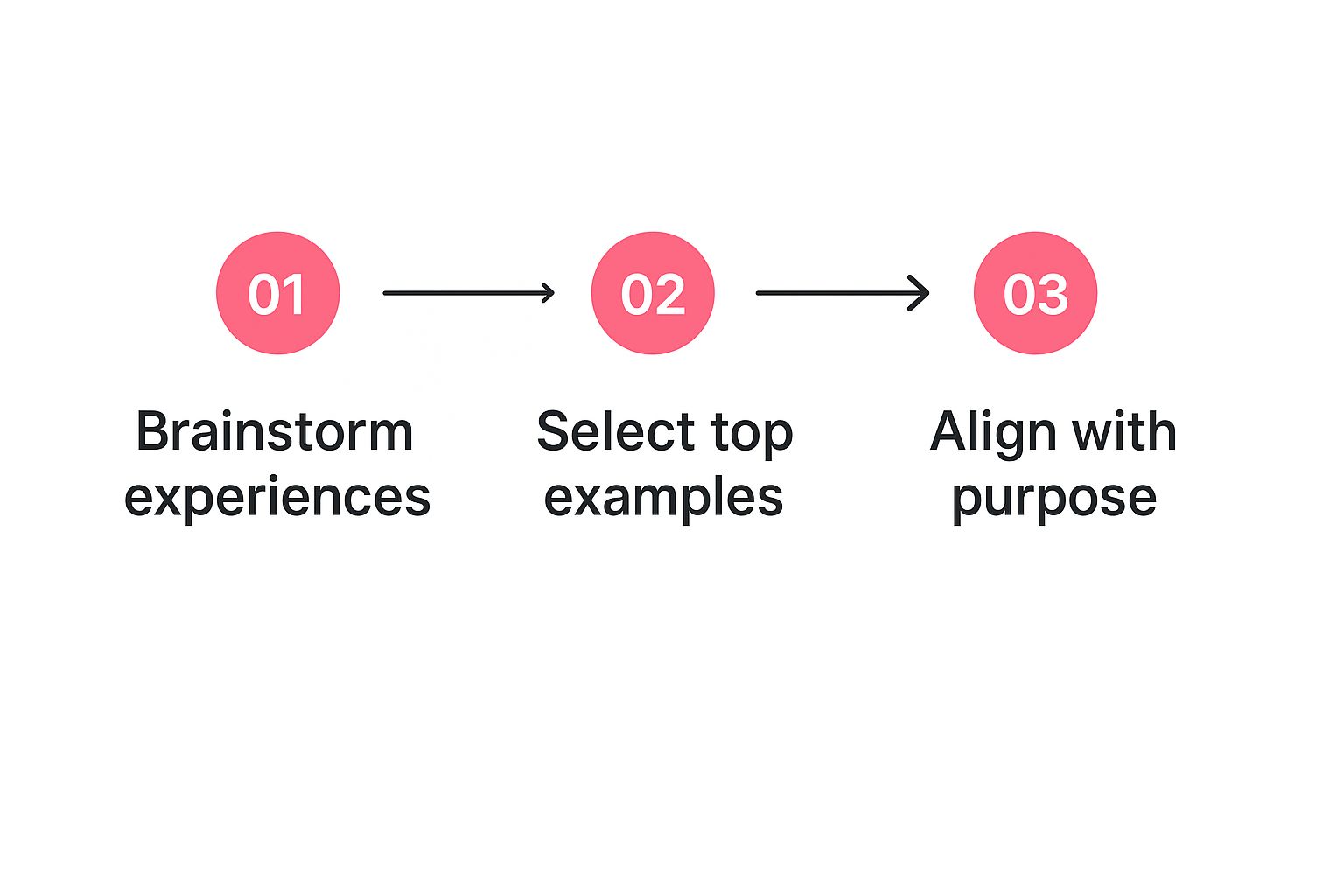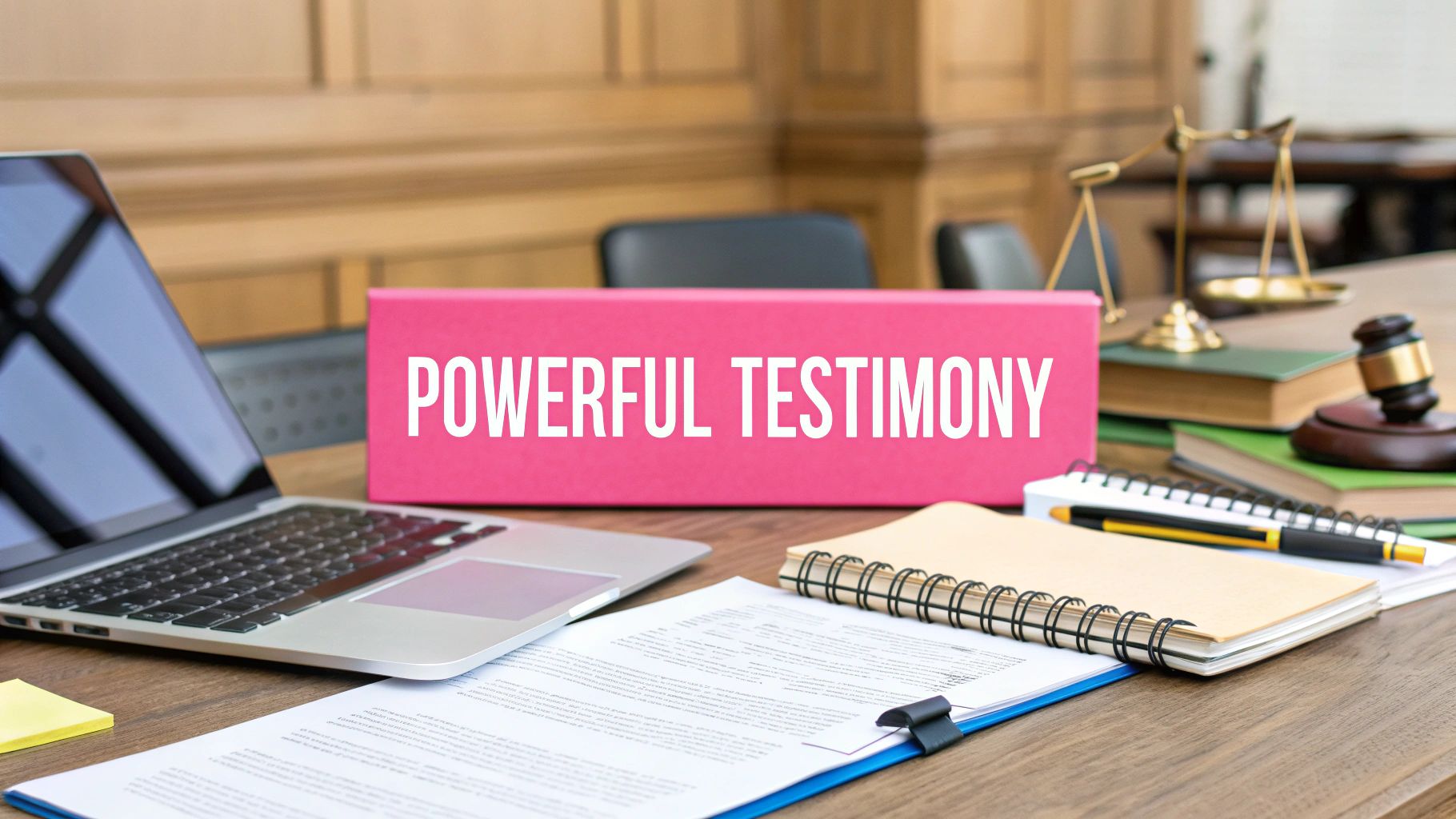Table of contents
Knowing how to write a testimony is really about turning your personal experience into a story that’s both powerful and believable. It’s more than just listing facts; it’s about structuring your story with a clear beginning, middle, and end, using real details and honest emotion to connect with your audience.
The Real Power of Your Personal Story

When you tell your story well, you're not just stating what happened. You're building a bridge of understanding between you and the people listening. It doesn't matter if it's for a legal case, a personal blog, or a community meeting—your story has the power to shift perspectives and inspire action.
This guide isn't about filling in a generic template. It’s about showing you how to build a narrative that feels completely authentic but is also structured to make the biggest impact. Think of this as the foundation for sharing your experience in a way that truly matters.
Core Principles for Impact
So, what makes a testimony truly hit home? From my experience, it boils down to three key things:
- Clarity: Your story needs to be easy to follow. Lay out the events in a logical, chronological order so no one gets lost.
- Credibility: This is crucial. Stick to what you personally experienced—what you saw, heard, and felt. Your power is in your firsthand account.
- Emotional Honesty: It’s okay to share your feelings, but always tie them back to specific events. This makes your story much more believable and relatable.
The value of a clear, well-structured testimony isn't just a theory; it's proven in some pretty high-stakes situations. Take the African Union’s Panel of the Wise, for example. They've long used personal testimonies in their diplomatic efforts. In fact, across more than 150 peace missions, reports have shown that 60% of successful conflict resolutions depended on insights gathered from methodical written and oral accounts. You can dig into their official reports if you're curious about their diplomatic practices.
To help you get started, let’s break down the essential pieces that every strong testimony should have. These components work together to make your story not just heard, but felt.
Core Components of an Effective Testimony
A summary of the essential elements that every powerful testimony should include to ensure it is credible and impactful.
Having these pieces in place gives your narrative a solid spine, making it easier for you to tell and for your audience to absorb.
A great testimony transforms a simple account into a compelling story. It isn’t just about what happened, but why it matters.
Ultimately, getting the hang of the fundamentals of how to write a testimonial will give you the confidence to share your truth and make sure it lands with the impact it deserves.
Gathering Your Facts and Finding Your Focus
 Before you even think about writing, a little prep work goes a long way. This isn't just about jotting down random memories; it's about laying a solid, factual foundation for your story. After all, a truly powerful testimonial is built on specific, concrete details you can clearly recall.
Before you even think about writing, a little prep work goes a long way. This isn't just about jotting down random memories; it's about laying a solid, factual foundation for your story. After all, a truly powerful testimonial is built on specific, concrete details you can clearly recall.
First up, gather any supporting information you have. Think dates, locations, names of people involved, and any direct quotes or key conversations that stick out in your mind. Don't filter yourself at this stage—just get it all down. The idea is to create a rich pool of facts to draw from later.
Create a Simple Timeline
To keep your story straight, it helps to map out a quick timeline of events. This simple exercise organises your thoughts and makes sure your narrative flows logically from start to finish.
A timeline helps you connect the dots and see the cause-and-effect relationships in your experience. That’s gold when you’re trying to explain it to someone else. It stops you from jumping around and losing your audience.
The most compelling testimonies are built on a framework of truth. By focusing on verifiable details first, you ensure your story is not only emotionally honest but also credible and unshakeable.
Pinpoint Your Core Message
With your facts laid out, it's time to find your focus. Ask yourself: what's the one single thing I want my audience to walk away with? Every detail you choose to include should feed into this main message. This helps you trim away interesting but ultimately distracting "noise."
This focus becomes even more critical in formal settings. For instance, in the African Union (AU) region, writing a testimony is a key part of legal and human rights advocacy. For the Fact-Finding Mission on Sudan, the systematic collection of written accounts was crucial for documenting human rights violations. You can see how these testimonies shape AU procedures and reports on their official site.
Knowing who you're writing for—whether it's a judge, a committee, or a potential customer—will shape your tone and which details you highlight. The core process stays the same, but the audience decides which facts matter most. It's a similar principle for businesses learning how to get customer testimonials; it’s all about guiding people to share their most focused, impactful stories.
Structuring Your Story For Maximum Impact
A powerful testimonial isn't just a random collection of thoughts; it needs a solid narrative structure to guide the reader. The easiest way to think about it is like a simple, three-act story. This isn't just for dramatic flair—it provides the clarity that makes your account believable and easy to follow.
Think of your introduction as the first act. This is where you quickly establish who you are and why you're sharing your story. Get straight to the point to set the context and grab your reader's attention from the get-go.
Next up is the body of your story, the second act where all the action happens. The real key here is to walk the reader through what happened chronologically. Use specific, sensory details to paint a vivid picture. Describe what you saw, what was said, and what you witnessed, but be careful not to drift into speculation. Stick to the facts.
Creating a Logical Narrative Flow
To make sure your story flows smoothly and is easy to follow, it helps to organise your thoughts before you even start writing. Think about all your experiences, pick out the most powerful examples, and make sure they directly support the main point of your testimonial.

As you can see, a compelling story isn't just a happy accident. It's the result of a deliberate process, carefully selecting the details that will have the most impact.
The value of well-structured accounts is recognised in many formal settings, too. For instance, approximately 75% of governance evaluations by the African Peer Review Mechanism are built on first-hand accounts. This just goes to show how critical clear, truthful, and logically structured testimony writing is for accurate assessments. You can even check out the details on how these initiatives use testimonials in their official reports.
The most effective testimonies follow a simple path: Here’s who I am, here’s what happened, and here is why it matters. Keep it clean and direct.
Finally, your conclusion ties everything together. This is your third and final act. It should briefly recap your main points and powerfully restate your core message, leaving a lasting impression on your audience. This last part cements the purpose of your testimonial, making sure your key takeaway is what people remember.
Choosing Language That Builds Credibility
The words you use have a direct line to how your testimonial is perceived. What you're aiming for is a tone that feels both sincere and authoritative, making sure your message lands with the trust it deserves. In my experience, simple, direct language is your best friend here.
It can be tempting to reach for complex industry jargon or overly formal phrases to sound more "professional". Resist that urge. It often has the opposite effect, making your story sound rehearsed or, even worse, just confusing the reader. When you're writing a testimonial, your number one job is to be crystal clear.
Express Genuine Emotion
Authenticity is everything, but showing emotion is a delicate dance. Over-the-top, dramatic language can, believe it or not, make you sound less credible. Instead of just telling the reader you were frustrated, show them through the facts of the situation.
Let's look at a real-world comparison:
- Less Effective: "I was extremely frustrated with our old system."
- More Effective: "Our old system caused us to lose three major client files in one month, forcing our team to work overtime just to recover the data."
See the difference? The second example ties the feeling of frustration to a tangible business headache. That's what makes it so much more powerful and believable.
Your goal is to present your truth with objective confidence. By sticking to the facts and maintaining a respectful, honest tone, you ensure your voice is not only heard but also trusted.
Maintain an Objective Tone
Even though your experience is personal, presenting it with a measure of objectivity gives it some serious weight. This isn't about stripping out your personality. It's about grounding your story in what actually happened, rather than just floating unsupported opinions. A confident, respectful tone quietly tells the reader you're a credible source.
As you figure out how to write your testimony, remember that your choice of words is paramount. Simple statements of fact are often far more compelling than grand emotional declarations. This approach lets your reader draw their own conclusions, which is a much more persuasive path to take. Let your experience speak for itself through clear, honest language.
Polishing Your Testimony with Confidence

Getting that first draft down is a massive win, but don't be tempted to hit 'send' just yet. The revision process is where a good story transforms into a great one. Think of it less like correcting mistakes and more like sharpening the blade of your message.
Your first editing pass should be ruthless. Hunt down anything that doesn’t directly support your core point. Is there a detail that’s interesting but ultimately irrelevant? Trim it. A sentence that wanders off on a tangent? Cut it. The goal here is to make your narrative as tight and focused as possible.
Here's a surprisingly effective trick I always recommend: read your entire testimonial out loud. It might feel a bit silly, but your ears will catch what your eyes skim over—things like clunky phrasing, repetitive sentences, or parts where the flow just feels off.
A polished testimony isn't just about perfect grammar. It's about making sure every single word earns its place, making your account clear, concise, and incredibly compelling.
The Final Checks for Clarity
Before you call it done, run through one last checklist. Go over every detail with a fine-tooth comb. Are the dates, names, and key events all correct and in the right order? These small details are the bedrock of your credibility.
Once you feel good about the content, ask a trusted friend or colleague to give it a fresh read. They can easily spot areas that might be confusing to someone who doesn't already know the full story. Their outside perspective is invaluable for ensuring your message lands exactly as you intended.
If you're still looking for ways to refine your draft, there are some excellent resources on writing a testimonial that can offer deeper insights.
This final polish gives your story the respect it deserves and gives you the confidence that you’ve presented your truth in the most impactful way.
Common Questions About Writing a Testimony
Even when you have a solid plan, a few nagging questions can pop up the moment you actually sit down to write your testimony. Let's tackle some of the most common ones I hear, so you can move forward with confidence.
Getting these details right is a huge part of learning how to write a testimony that people not only read, but also respect and believe.
How Long Should My Testimony Be?
There’s no magic number here. The right length really just depends on the context and who you're writing it for. Your main goal should be to tell your full story clearly without waffling on.
If you haven't been given any guidelines, a good rule of thumb is to aim for somewhere between one to five pages.
This usually gives you enough room to include all the important details without adding a bunch of fluff. Always remember that clarity is more important than length. Get every key fact and event down, but be ruthless in editing out anything that doesn't directly back up your main point.
What Is the Biggest Mistake People Make?
The most common and damaging mistake I see is when people include speculation or hearsay. The real power of your testimony comes from your direct, firsthand experience. You absolutely have to stick to what you personally saw, heard, and did.
Your testimony's strength comes from its authenticity. Avoid guessing at someone else's intentions or reporting what another person told you. Sticking to the facts is the best way to maintain your credibility.
The moment you start guessing, you weaken your entire story. A truly effective testimony is built on the solid ground of your own personal observation, not on assumptions about things you never actually witnessed.
Is It Okay to Include My Emotions?
Yes, absolutely. Your emotions are a real and valid part of your experience. The trick is to present them in a way that feels genuine and connected to the facts.
Instead of just saying, “I was scared,” describe the physical event that made you feel that way. It makes the emotion much more powerful and believable.
For example:
- Weak: "I was terrified."
- Strong: "My heart was pounding as I heard the footsteps approaching my office door after hours."
This "show, don't tell" approach grounds your feelings in reality. It creates emotional honesty, not melodrama, which can seriously undermine your credibility.
Can Someone Help Me Write My Testimony?
Of course. In fact, getting a second pair of eyes on your draft is often a smart move. A friend, family member, or even a legal advisor can help you organise your thoughts and spot any issues with clarity, grammar, or typos.
But, and this is a big but, the story and the words have to be yours. Their job is to help you polish your account, not to write it for you or change the facts. The final version must be a true and accurate reflection of your personal experience.
At Testimonial Donut, we help businesses capture authentic customer stories effortlessly. Our platform makes it simple to request, collect, and showcase powerful testimonials that build trust and drive growth. See how we can help you turn customer feedback into your most valuable marketing asset at Testimonial Donut.



